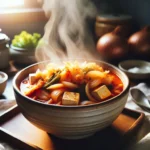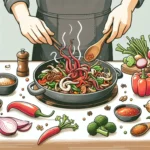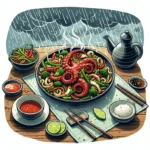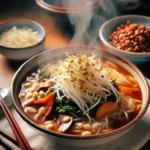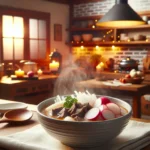Imagine a cozy evening, the aroma of simmering flavors wafting through your kitchen. Perfect Doenjang Jjigae, known for its rich and savory characteristics, invites you to explore the depth of Korean cuisine. This iconic stew, with its soulful essence, represents comfort in a bowl. The journey to creating your masterpiece begins with understanding essential ingredients, followed by an intentional step-by-step approach. As you dive into the art of this dish, countless variations await, allowing for a personal touch that can transform your culinary experience. Let’s embark on this flavorful adventure together!
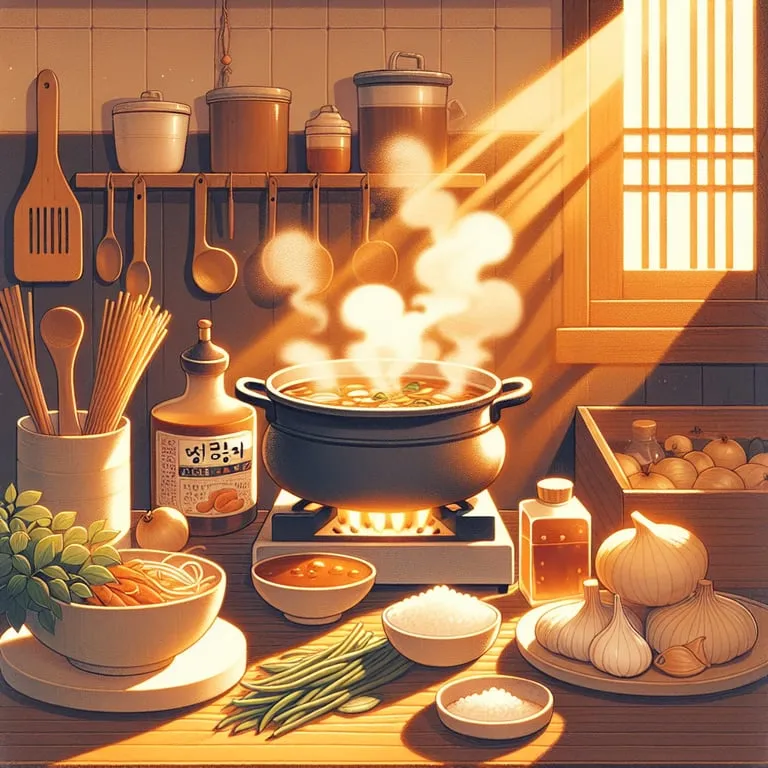
Essential Ingredients for Authentic Doenjang Jjigae
When diving into the world of Korean cuisine, one dish that stands out with rich flavors and comforting warmth is Doenjang Jjigae. To recreate this authentic stew, certain essential ingredients serve as the backbone, creating that beloved umami-packed experience everyone craves! 🌟
1. Doenjang (Soybean Paste)
The star of the show! Doenjang is fermented soybean paste and boasts a robust flavor profile. To achieve the best results, using about 4 tablespoons of high-quality doenjang will set the perfect foundation. This key ingredient brings depth and richness, essential for an authentic taste. The fermentation process, which can take several months, enhances its complex flavors. 🍜
2. Tofu
Soft or firm tofu? The choice is yours, but about 200 grams of cubed tofu adds creaminess and texture that balances the stew. Tofu is a versatile ingredient that absorbs the flavors of the broth, enriching each mouthful. Plus, it’s packed with protein, making this dish not only tasty but nutritious! 🥗
3. Vegetables
A colorful array of vegetables is vital to making the stew both visually appealing and delicious! Common choices include zucchini (1 medium), potatoes (1 medium), and onions (1 medium), sliced into bite-sized pieces. Add about 100 grams of mushrooms if desired, such as shiitake or enoki. These veggies enhance the stew’s flavor and provide a delightful crunch! 🥒🥔
4. Seafood or Meat
For a heartier stew, consider adding 100-200 grams of meat (like pork belly) or seafood (such as clams or shrimp). The choice of protein not only adds flavor but also offers various textures to cater to different palates. Marinating the meat briefly in a hint of doenjang can elevate the flavor even further! 🍤🥓
5. Gochugaru (Korean Red Pepper Flakes)
For those who enjoy a kick of heat, incorporating about 1 tablespoon of gochugaru will light a fire in your Doenjang Jjigae! This ingredient not only adds spice but also a beautiful red hue to the dish. Adjust the amount based on your preference for spice—because what’s life without a bit of excitement? 🌶️🔥
6. Garlic
Keen to add aroma? Chopped garlic (around 3 cloves) infuses the stew with a warm, soothing fragrance that’s hard to resist. It’s the soul of many Korean dishes, providing a touch of earthiness that ties all the flavors together. 🧄✨
7. Spring Onions
Finishing your stew with chopped spring onions (about 2 stalks) not only adds a fresh crunch but also a vibrant pop of color. Sprinkle them in just before serving for the best flavor impact. They’re like the cherry on top of your culinary masterpiece! 🧅💚
8. Water or Broth
Finally, combine all these delightful ingredients with 4 cups of water or a good-quality vegetable/chicken broth to make the stew rich and flavorful. The broth choice can elevate the flavors even more, providing a heartier taste profile. 💧🥣
Every ingredient is significant and plays a role in crafting that perfect harmony of flavors. The right balance will ensure your Doenjang Jjigae transports you straight to a cozy Korean kitchen, filled with inviting aromas and heartwarming memories! 🫶
Finding the best ingredients might take a little effort, but each bite will be worth the journey, bursting with the authentic taste of home. So, gather these essentials, unleash your culinary skills, and enjoy crafting your very own Doenjang Jjigae masterpiece! 🍲❤️
Step-by-Step Preparation Instructions
When it comes to crafting the perfect Doenjang Jjigae, every step you take contributes to the rich, savory depths of flavor that characterize this beloved Korean stew. Prepare yourself for an exciting culinary journey full of delightful aromas and tastes! ✨ Let’s dive in!
1. Gather Your Ingredients
Start by assembling all essential ingredients to ensure you have everything ready. You will need 3 tablespoons of doenjang (fermented soybean paste), which serves as the backbone of the stew. Prepare 200 grams of tofu (preferably firm), one medium onion, two green chilies, and 1-2 cups of seasonal vegetables such as zucchini and mushrooms. Don’t forget about a few garlic cloves and, optionally, some seafood or meat for that extra umami punch! 🦐🍄
2. Prepare the Broth
In a pot, combine 4 cups of water with 1 tablespoon of Korean chili powder (gochugaru) to kickstart the flavor. Bring this concoction to a boil before adding 1 tablespoon of the savory doenjang. This initial simmering is vital, as it allows the paste to meld harmoniously with the boiling water, infusing the broth with its deeply satisfying taste. 🌊
3. Chop and Dice Your Veggies
While the broth is bubbling away, wield your knife to chop the vegetables. Aim for uniform sizes! Slice the onion into wedges, and cut the zucchini into half-moons. The key is to ensure everything cooks evenly, so don’t skimp on the details! Slice the garlic finely to unlock its aromatic potential—don’t be shy with it! 😉
4. Incorporate the Flavor Makers
Once your broth is ready, it’s time to add the diced veggies. Toss in the onion and garlic first, letting them mingle in the pot for about 5 minutes until they soften and begin to release their scents (oh, that aroma!). Next, add the zucchini and mushrooms, bringing forth an array of textures. If you’re using meat or seafood, this is the moment to add those treasures! 🥩🥬
5. Simmer to Perfection
Now let the pot simmer gently for around 10-15 minutes. The goal is to let the vegetables soften and enrich the broth even further. Occasionally stir the pot, ensuring all the ingredients harmonize beautifully. At this stage, you’re also welcome to taste the broth, adjusting with extra doenjang or seasoning according to preference.
6. Choose Your Tofu
After the veggies are tender, gently add the tofu. Cut into comfortable bite-sized cubes, tofu is the perfect complement to the robust stew! Allow it to simmer for another 5 minutes—this will warm the tofu without breaking it apart. A delicate dance of flavors unfolds with each addition! 💃
7. Finishing Touches
Just as you are about to serve, sprinkle in the chopped green chilies for a dash of spice and color. It’s the cherry on top, adding bright notes and an extra kick! Add a splash of sesame oil for that rich, nutty aroma that brings everything together. How delightful! 🌟
8. Serve and Enjoy
Finally, ladle that glorious stew into bowls and serve it hot, accompanied by steaming rice and traditional banchan (side dishes). Gather around with your loved ones, and bask in the warmth and comfort that Doenjang Jjigae brings. It’s not just a meal; it’s an experience that speaks to the heart! 💖
With these steps, your Doenjang Jjigae will not only tantalize the taste buds but also uplift the soul. Each ingredient plays a vital role in the symphony of flavors—embrace the process and savor every moment! 🥳
Tips for Achieving the Best Flavor
When crafting the perfect doenjang jjigae, the flavor is everything! 🌟 To elevate your stew to the next level, consider the following tips that will make your taste buds dance with delight.
Quality of Doenjang
First and foremost, the quality of the doenjang (fermented soybean paste) you choose plays a significant role in the overall taste of your jjigae. It’s advisable to use a high-quality, traditionally fermented doenjang, as this will impart an authentic umami flavor. Aim for brands that have been aged for at least six months to one year. This aging process enhances the depth and richness of the paste, making your stew more complex and satisfying.
Broth Matters
Now, let’s talk about broth! 🌊 A great jjigae starts with a flavorful base. If you have time, use a homemade broth made from dried anchovies (myeolchi) and kelp (dashima). This infusion takes just about 15-20 minutes and adds a savory kick that store-bought broths simply can’t match. For every 4 cups of water, include about 10-12 dried anchovies and a small piece of kelp. After simmering, strain the broth for pure, clean flavor. The right broth will set the stage for a masterpiece!
Ingredient Ratios
Another essential factor is the ratio of ingredients. A common guideline is to maintain a balance; for every 2 tablespoons of doenjang, use 1 tablespoon of gochugaru (Korean red pepper flakes) for a hint of spiciness. Additionally, consider the texture and taste of your vegetables. Potatoes, zucchini, and mushrooms work beautifully together—this colorful blend not only satisfies the palate but also adds visual appeal. The combination of 1 medium potato, 1 zucchini, and ½ cup of mushrooms will create a delightful texture that contrasts nicely with your protein of choice, whether it be tofu, beef, or seafood.
Seasoning Properly
Don’t forget about the seasoning! Adding a pinch of salt and a splash of soy sauce can enhance flavors even further. Remember that seasoning should be adjusted gradually—start with a pinch of salt and taste as you go, allowing the flavors to develop. After all, you can always add more, but it’s difficult to take away! 😅
Cooking Time
Timing is critical in cooking! As you simmer, let your stew cook for about 25-30 minutes on low heat. This gentle cooking allows the flavors to blend beautifully, creating a harmonious broth that envelops every ingredient. Also, towards the end of cooking, consider adding a tablespoon of sesame oil for a nutty finish, which accentuates the overall complexity.
Experiment with Fermentation
Lastly, experiment with fermentation! Incorporating a tablespoon of fermented ingredients like kimchi or a touch of sour doenjang will bring a tangy depth to the stew. This method adds layers of flavor that are sure to surprise and delight your guests. Remember, cooking is as much about creativity as it is about the recipe. Each batch of doenjang jjigae can tell a different tale! ✨
All these tips are designed to help you achieve a symphony of flavors in your doenjang jjigae. By selecting the right ingredients, paying attention to ratios, and practicing thoughtful cooking techniques, you will unlock the secrets of an authentic Korean stew that is both comforting and packed with flavor. Ready to get cooking? Let’s make some magic in the kitchen! 🍲💖
Variations to Customize Your Stew
When it comes to crafting the perfect doenjang jjigae, variability is key! The beauty of this beloved Korean stew lies in its customizable nature, allowing each home cook to make it uniquely their own. From experimenting with ingredients to adjusting the level of spice, the possibilities are endless. Let’s explore some delightful variations and how they can transform your stew into something extraordinary ✨.
1. Protein Choices: Go Beyond the Basics!
While the classic recipe often features tofu and pork, consider diversifying your protein selections! For a lighter option, chicken breast or thighs can add a succulent touch. If you’re feeling adventurous, seafood such as shrimp or clams can lend a delightful brininess—perfect for summer! You might even opt for beef, which imparts a richer flavor to the broth. A robust 200-300 grams of protein per serving can provide a hearty and fulfilling meal that satisfies any appetite.
2. Vegetable Wonderland: Color and Texture!
Vegetables not only enhance flavor but also create a harmonious medley of textures. Traditional choices include zucchini, mushrooms, and radish, but there’s much more to explore! How about tossing in some colorful bell peppers, baby bok choy, or even sweet corn? Carrots can add a natural sweetness, while leafy greens like spinach can impart freshness! Aim for a vibrant combination—around 250 grams of mixed vegetables can create a stunning visual and provide essential nutrients. Don’t be shy; experiment with what’s in season 🍅🥬!
3. Spice it Up: Heat Level Adjustments
Not every stew needs to be spicy, but a touch of heat can elevate the flavor experience! If you enjoy a fiery kick, why not introduce some gochugaru (Korean red pepper flakes) or fresh chilis? Start with half a tablespoon and adjust to your preference. For those who prefer milder flavors, reduce the pepper content and instead enhance the depth with ingredients like black pepper or even a hint of smoked paprika. Remember, the key is balance; subtlety often leads to sophistication 🌶️🔥!
4. Umami Boosters: Layers of Flavor
Seeking that umami la-la-land? Incorporating ingredients like miso paste, seaweed (such as kombu), or even shiitake mushrooms can provide a robust depth that transforms your stew! Adding a tablespoon of tonkatsu sauce or a splash of soy sauce can give your jjigae an extraordinary twist. Whichever path you choose, aim for that heavenly flavor complexity—especially if you can simmer your stew for an extra 30 minutes to allow these flavors to meld. The result? Pure magic in a bowl ✨😋!
5. Personal Touch: Cultural Inspirations
Why not take inspiration from other culinary traditions? Try incorporating coconut milk for a Thai twist, or some curry paste for an Indian flavor fusion. A mere 100-200 ml of coconut milk can introduce a creamy twist that harmonizes with the doenjang. You could even explore adding miso soup base alongside your doenjang for an even deeper richness! Remember, it’s all about what resonates with your taste buds and creativity ✨.
6. Garnishing for Impact: The Final Touch
Never underestimate the power of garnishes! A sprinkle of fresh scallions, a hint of sesame oil, or even traditional perilla leaves can make all the difference. A squeeze of lime or lemon juice just before serving can brighten the entire dish, making it more dynamic. Moreover, serving the stew with a side of kimchi not only complements the jjigae but diversifies the meal experience. So, don’t skimp on presentation; a beautifully garnished stew is as satisfying visually as it is to eat! 🌿🍋
Embrace these variations to personalize your doenjang jjigae! This stew is a canvas awaiting your artistic touch—how will you create your masterpiece? Remember, cooking is about exploration and joy; each variation brings a new adventure to your table. Now, let’s get cooking! 🌟
In the world of culinary exploration, Doenjang Jjigae stands as a beacon of comfort and innovation. With each simmering pot, you embark on a journey through the rich tapestry of Korean flavors. May the essential ingredients enrich your kitchen, while the step-by-step guide empowers you to create your masterpiece. Embrace the tips shared, for they hold the key to unlocking the stew’s secrets. Remember, variations are your friends—don’t hesitate to add a personal touch! Let each spoonful not just nourish, but inspire a deeper connection to the culinary arts. Happy cooking, and may your kitchen be filled with warmth and joy!
